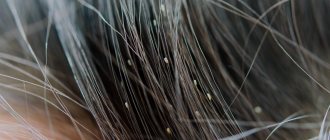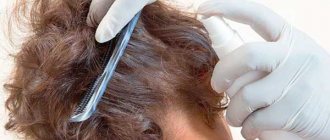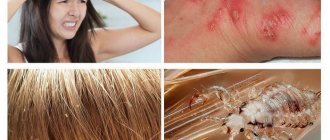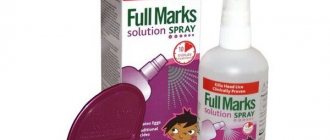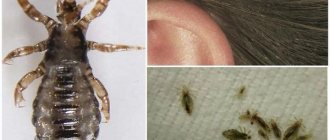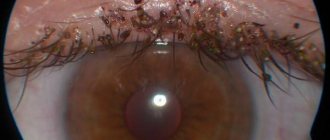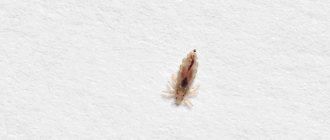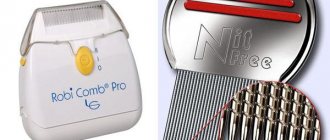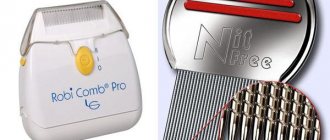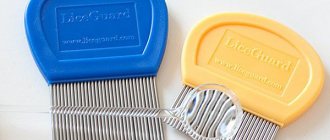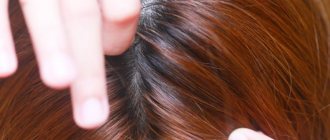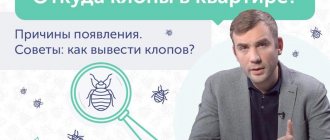Pediculosis is an ancient disease. Humanity has come up with a lot of ways to get rid of lice. Along with modern pharmaceutical drugs, old proven folk recipes continue to be used. Among them is hair coloring. Does hair dye kill lice and nits? This is a question that girls and women often ask.
Quick facts about lice:
- • Parasites cannot fly or jump; they crawl from head to head, clinging to hair using hooks located at the ends of their legs.
- • Adults lay about 5 eggs (nits), which they attach to the hair with a thick sticky substance.
- • Young lice (nymphs) hatch from the nits after 7-10 days.
- • Lice cannot survive without a host for more than 48 hours.
- • Itching with pediculosis only in 14-36% of cases
In recent years, pharmaceutical anti-pediculosis drugs have become less effective. This is because head lice have developed resistance (resistance) to the insecticides they contain. This is the main reason why many people look for unusual lice treatments, such as hair dye.
Hair dryer in the fight against pediculosis
The hairdryer weakens parasites and can destroy up to 96% of parasites, but only when used correctly.
- Wash your hair with as hot water as possible.
- Place a diffuser on the hairdryer.
- Dry with a hairdryer at high temperatures for a long time, bringing it as close to the skin as possible.
- Dry for 10 minutes, then take a break and repeat the procedure 2 more times.
- Carry out combing.
- Blow-dry for a week, as nits hatch in 7 to 10 days.
If you discover a parasite infestation, do not rush to go to the pharmacy. You may have everything you need at hand. Use products to combat lice correctly and you will forget about the unwanted neighborhood.
Do lice live on colored hair?
Many women are convinced that regular dyeing helps get rid of lice. But practice shows that parasites feel equally good on clean or dirty, curly or straight, natural or dyed hair.
The chemicals contained in certain types of hair dyes do have a negative effect on lice, but this requires direct exposure. If the infection occurs after dyeing, then the parasites will live and multiply in the same way as on natural hair. Lice feed on blood. The chemicals contained in paints do not penetrate into the human bloodstream, otherwise we would experience unpleasant side effects after painting. Thus, changing hair color has no effect on lice.
Efficiency
Many people assume that dyeing your hair is enough and the lice will die. But a one-time procedure will not bring results. It has been proven that the dyeing method helps to partially get rid of parasites.
Dyeing your hair three times is considered optimal. The break is approximately a week.
Important! Regular dyeing has a negative effect on the scalp. The protective layer loses its strength, the hair loses its healthy, vibrant appearance.
Dye is a compound of chemical elements that negatively affects hair when used regularly.
To effectively get rid of parasites:
- distribute the chemical over the entire surface of the head, each strand must be treated carefully;
- put a plastic bag or cap on your head;
- wrap your head with a towel;
- let the paint set for 30-45 minutes;
- To wash off paint, use water at room temperature and use a vinegar solution. To prepare it you will need 0.2 liters of vinegar and 0.5 liters of water.
Peroxide works better under such conditions. Thanks to the vinegar solution, it is much easier to comb your hair and get rid of nits and lice.
Does hair dye kill lice?
Many modern paints cannot be called effective against lice. They are made from plant extracts without the addition of toxic substances. To kill parasites, you must choose paint that contains powerful chemicals. They usually contain two components: ammonia or hydrogen peroxide. It was previously thought that both of these ingredients could kill lice. But that's not true. In recent years, parasites have become completely immune to hydrogen peroxide.
Ammonia paint has a certain anti-pediculosis activity. Ammonia is a caustic, alkaline substance that can kill lice with prolonged exposure. But ammonia is not effective against nits, which are protected by a dense shell. Therefore, if you decide to use hair dye against lice, you need
- 1. Be sure to buy paint that contains ammonia.
- 2. Leave the dye on your hair for at least 40 minutes.
- 3. After the coloring procedure, comb your hair thoroughly with a fine-tooth comb.
Since even ammonia paint is not effective against nits, the staining procedure will have to be repeated after 7-10 days.
Hair dye: pros and cons (contraindications) of this method
Anti-lice hair dye has the only advantage - it is the ability to combine the dyeing procedure with anti-lice treatment. However, one should take into account the fact that the effectiveness of paint against parasites directly depends on the amount of ammonia it contains. And the more ammonia in the dye, the higher the risk of negative effects on the hair and scalp.
Dermatologists do not recommend using hair dye to treat head lice in children. During childhood, hair is much thinner and more vulnerable to damage from chemicals contained in coloring products. Children are also more prone to allergic reactions, the consequences of which can be very severe.
Additional disadvantages of this method of treating head lice include:
- • Repeated dyeing leads to weakening of hair
- • Hair dye does not kill nits
- • Hair dye is often more expensive than pharmacy anti-lice medications
- • Frequent dyeing significantly increases the risk of an allergic reaction.
In addition, coloring can complicate the process of getting rid of lice. Insects and nits become the same color as your hair, making them almost undetectable.
Methods of application
To get rid of lice with hairspray, you need to carry out the treatment correctly. To obtain good results, processing is performed as follows:
- first wash your hair thoroughly with regular shampoo;
- wait until the hair is dry or dry it with a hairdryer;
- apply the preparation to the strands along the entire length, paying more attention to areas near the roots;
- to achieve the desired effect, you need to use one or two bottles per procedure;
- after this, the head is covered with plastic wrap and wrapped in a towel to obtain a thermal effect;
- after eight hours, wash your hair with plenty of water and shampoo;
- Use a special comb to comb the hair to completely eliminate lice and nits.
During therapy you need to follow these recommendations.
This will help avoid unpleasant consequences. To prevent spraying and inhaling varnish from making you feel worse, apply the spray outdoors or in a well-ventilated room. It is better to put a damp cloth on your face and hold your breath as much as possible. With the help of varnish, relief is felt from the first procedure. But to prevent relapse, you can re-treat your hair after a week. Thanks to this, in just two sessions you can completely forget about the problem.
What safety methods should be used with this method of getting rid of lice?
Despite the fact that many of us consider the dyeing process a routine procedure, we should not forget about the safety rules:
- 1. Before the procedure, check the paint for an allergic reaction. To do this, apply a small amount of paint to the skin of your hand (elbow area or wrist) and leave for 12 hours. If during this time no signs of allergy appear - itching, swelling, redness - the paint can be used.
- 2. Carefully examine your scalp before the procedure. Do not use hair dye if there are wounds on the scalp that appeared after combing lice bites. When chemicals get into these wounds, they can cause burns or allergies.
- 3. Use disposable gloves to protect your hands
- 4. Be careful not to get the coloring agent in your eyes or mouth.
- 5. Avoid inhaling paint fumes. Carry out the procedure in a well-ventilated area.
As mentioned above, ammonia paints should not be used to treat lice in children.
Alternative Treatments
All methods of getting rid of lice can be divided into three main groups:
- • Mechanical removal. This method involves removing live parasites and nits manually. To do this, take a fine-toothed comb and comb your hair thoroughly. The advantage of this method is that it is absolutely safe. Disadvantage: you will have to spend a lot of time and effort to completely get rid of lice.
- • Home remedies. There are a huge number of lice recipes that can be used at home. These include: essential oils, kerosene, mayonnaise, olive oil, vinegar and many others. The main disadvantage of these methods is low efficiency. In most cases, treatment is delayed and ultimately the insects have to be removed mechanically. The advantages include financial savings - most ingredients can be found in every kitchen
- • Pharmacy drugs. Today you can find a wide range of pediculicides in pharmacies. These can be shampoos, emulsions and sprays. The undoubted advantage of using pharmaceutical products is that they are all pre-tested and are considered relatively safe. The downside is that lice have become resistant to insecticides, so many drugs are simply ineffective.
Advantages of the product
This method of treating pediculosis has many advantages:
- efficiency - the use of a fixing solution guarantees the complete destruction of lice and nits;
- safety – absence of toxic substances in the varnish;
- low cost compared to pharmacy pediculicidal drugs (the price of Prelest varnish is within 180 rubles);
- easy way to use.
How to get rid of lice without unnecessary problems?
The main problem in the treatment of head lice is that lice quickly adapt to toxic substances (insecticides) and stop responding to them. "Paranit" has a fundamentally new mechanism of action. They contain dimethicone and mineral oil.
Dimethicone is a silicone-based polymer that is found in many cosmetics. It helps moisturize the skin, creating a thin barrier. So why did this substance, safe and beneficial for humans, become destructive for parasites?
The answer lies in the life activity of lice. They have seven openings (spiracles) on each side of the body that merge into the trachea. The tracheae branch and form a thin network that supplies insects with oxygen. Through the same network they remove excess fluid after drinking blood. Due to the high surface tension of water, it does not penetrate the microscopic spiracles. And dimethicone copes with this task. It tightly clogs the respiratory system of lice, depriving them of oxygen and disrupting their water balance. This substance also affects nits in the same way - without the ability to breathe, they die.
Since dimethicone and mineral oil are non-toxic substances, Paranit anti-pediculosis products can be used to treat children from 3 years of age, and Paranit Sensitive lotion is suitable for children from 1 year of age and pregnant women. In addition, the processing can be repeated many times. Paranit products are available in various forms, and therefore are suitable for treating all family members. This is a simple and effective way to deal with an unpleasant problem without risk to health.
